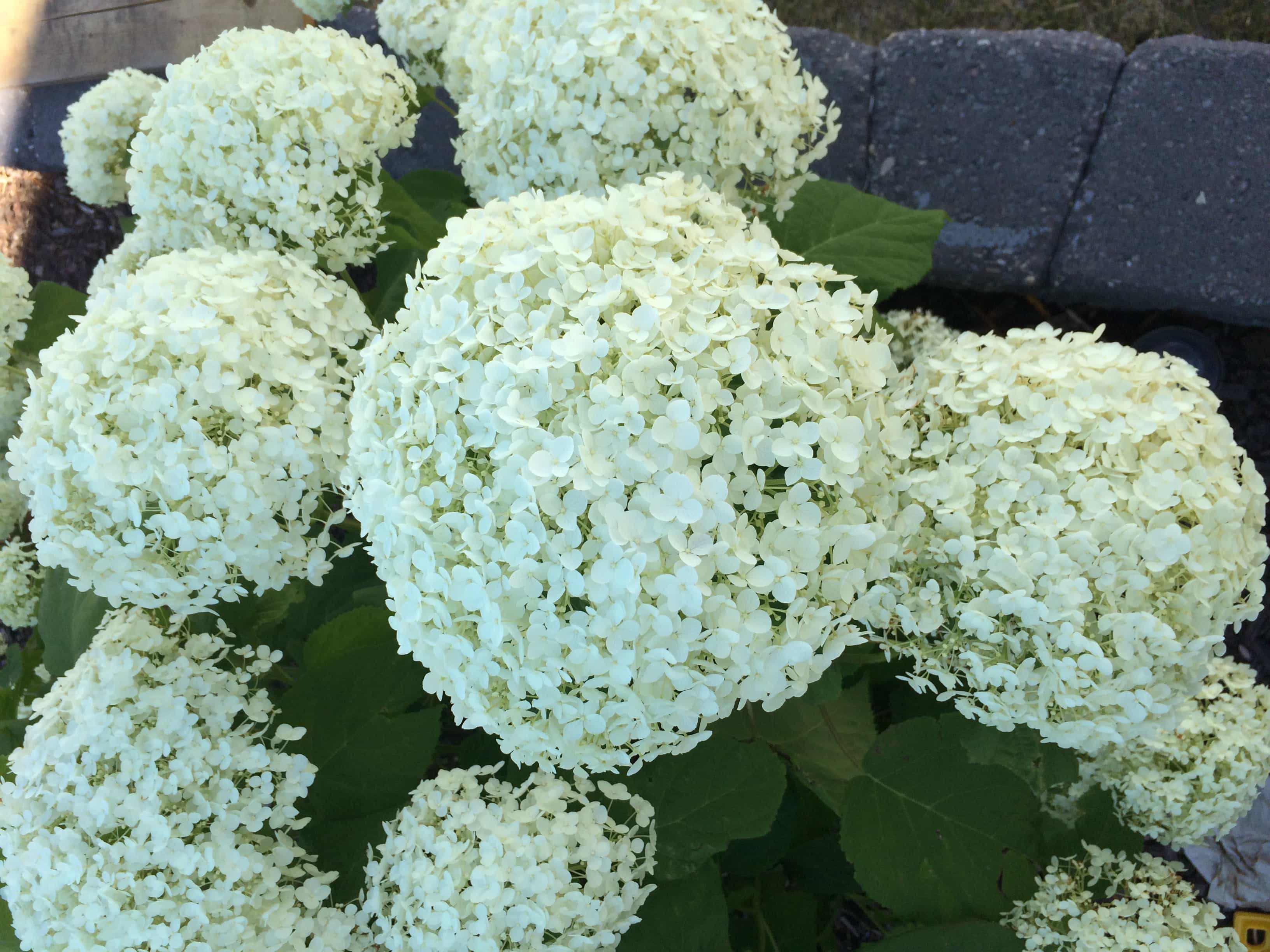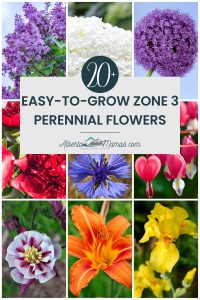These are some of my favourite, easy to grow perennial flowers for Zone 3a (Edmonton, Alberta).
Judith is an eco-mom in Edmonton who is passionate about green, toxin-free, healthy living. She shares her journey and experiences on Juicy Green Mom. You can follow her on Instagram, Facebook, Twitter, and Pinterest.
I’ve lived in Edmonton my whole life and grew up with summer memories of sitting in a cherry tree and picking raspberries in my backyard. As an adult, I’ve begun to appreciate the joys of a beautiful garden. Because I’m also a bit of a lazy gardener, I love planting perennials that will come back year after year.
Table of Contents
Annabelle Hydrangeas (feature photo)
Hydrangeas are my absolute favourite flowers, I even had them in my wedding bouquets. When I got the opportunity to landscape my backyard from scratch, I knew I wanted some kind of hydrangeas.
I had Annabelle hydrangeas put into a raised bed and they have been producing beautiful round white bouquets of blooms for me for 10 years. They do well in sun to part shade with plenty of water.
Be careful selecting hydrangeas as some box stores carry varieties that don’t tolerate our cold winters.
Other hydrangea varieties to consider include:
- Lime Light (most cold hardy)
- Vanilla Strawberry (very large plant)
- Berry White (similar to Vanilla Strawberry, but with stronger branches)
- Diamond Rouge (red flowers!)
- Little Lime Punch (great for smaller spaces)
- Quick Fire Fab (early blooms)
- Puffer Fish
Bleeding Heart
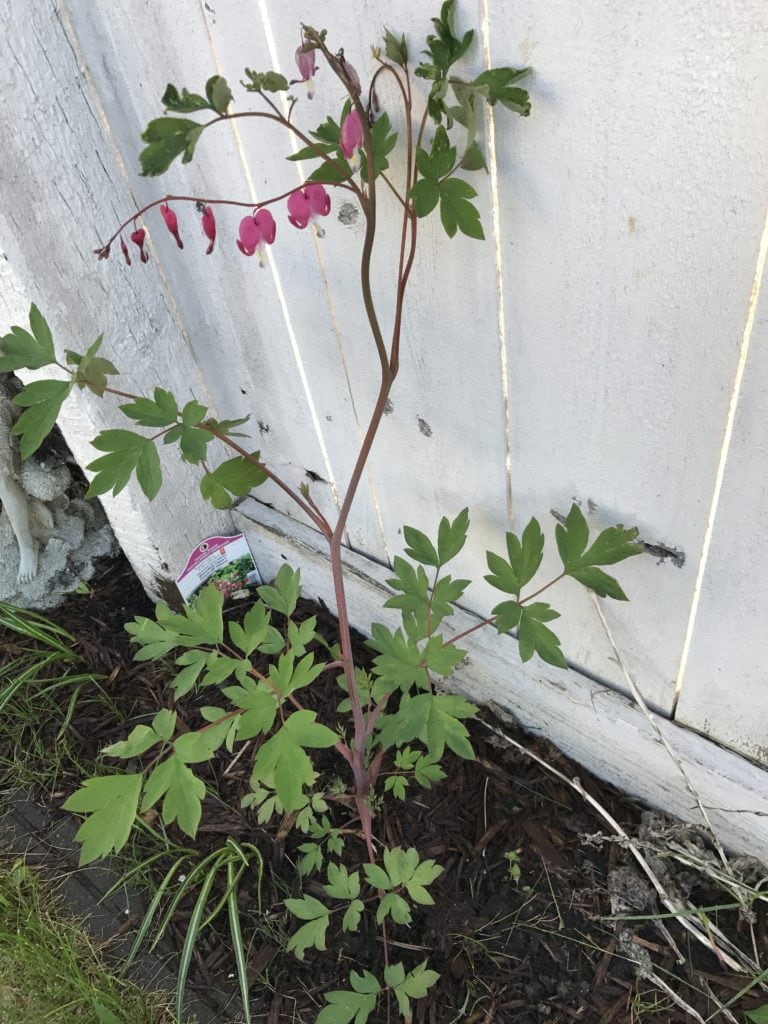
I thought bleeding hearts would be really hard to grow because they look so delicate – but I finally took the plunge and got a few plants to try. I’ve had them for 2 years now and they grow larger and more beautiful every year. They do well in the part shade mulched area I put them in.
Aster
Ranging from white to pink to pale purple, this daisy-like plant blooms later in the season and is loved by butterflies and bees.
I love having a late blooming perennial in my garden so I’m not depending on annuals to add colour in August!
Cornflower/Bachelor Buttons
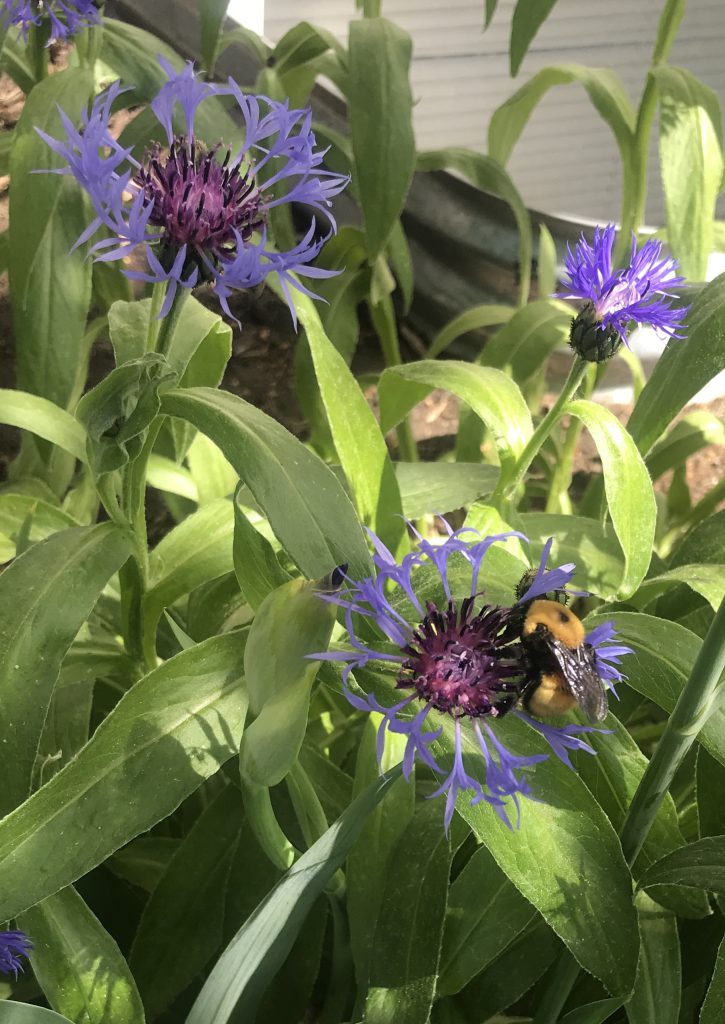
A late May to early June bloom, bachelor buttons are happy in mixed to full sun and are a favourite of big, fuzzy, friendly bees. Cut them down once they’re done blooming and you’ll often get a second bloom in the fall!
If you know someone with them in their garden already they split very easily. See if you can dig up a clump from them instead of spending $10-20 at a garden center for a single plant. If you don’t have a “friend with (garden) benefits” there are many plant exchange groups you can find them in as well.
This purple-blue is the most popular, but they also come in white with pink centers.
Salvia
If you love the look of lavender but live in Zone 3 or 4, consider salvia! While you don’t get the lovely smell of lavender, salvia has a similar growth pattern and pretty purple flowers that will wave in the wind. And survive our winters without special treatment!
Columbine

When I saw my first columbine, I fell in love with the blossoms. They are so strikingly beautiful! I’ve had my shrub for 2 years and it started out as a tiny thing. It grew very quickly and is now self-seeding around the mulched area I have it in, which I am perfectly happy with!
It is super healthy in the shady spot it’s in, and supposedly the shrub will continue to grow and spread, which means it will offer great coverage.
Allium
Alliums are bulbs in the onion family, best planted in the fall before frost. Ornamental alliums produce gorgeous globe blooms. This is the second year I’ve had them, and they are just amazing! I have them in a part shade area and they don’t require much water.
Milkweed

Milkweed is essential for monarch butterflies to survive, and the David Suzuki Foundation has been campaigning to promote more milkweed planting to support the butterfly population. I have 2 plants growing in full sun that I have now harvested seeds from to keep propagating more. It grows quickly and produces unique big blooms. It seems to tolerate little water and lots of sun.
Delphinium
These beautiful, spikes of flowers are gorgeous at the back of your garden for a pop of colour. Most grow four to six feet high, though there are some varieties that max out at two to three feet.
If you have pets you may want to skip this one – it is highly toxic to cats, dogs and even people if ingested.
A similar looking plant to consider are hollyhocks. While they can irritate the skin they are not poisonous. Hollyhocks are a self-seeding biennial rather than perennials.
Irises

Coming in a wide range of colours and heights, there are irises available to suit any garden colour scheme. They bloom from mid-May to late June, depending on the variety, and prefer full sun. I have mine spread out in one bed that varies from full to part sun, and the ones that get less sunlight grow about a third smaller and bloom a week later than the full sun plants.
Irises are best planted in a clump of a dozen plants over a 1×2 foot space (six to eight inches between plants) as they will spread over the years. I usually split mine every 5-6 years. If they get too crowded the plants will start to grow smaller. The best blooms happen two to four years after planting/thinning.
Trim the leaves into a triangle once they start to brown if you like to keep your garden neat. I usually clean them up in the spring to give bugs a place to stay over the winter (and I’m lazy).
Echinacea (Coneflower)
Grow your own cold medicine! Well, the science on that is mixed, but you can use the leaves to brew your own tea that MAY boost your immune system. And the flowers are pretty!
Be cautious about what variety you purchase. Many coneflowers are only zone 4 hardy. “Pow Wow Wild Berry” and “Green Twister” are both zone 3 options.
Lilacs
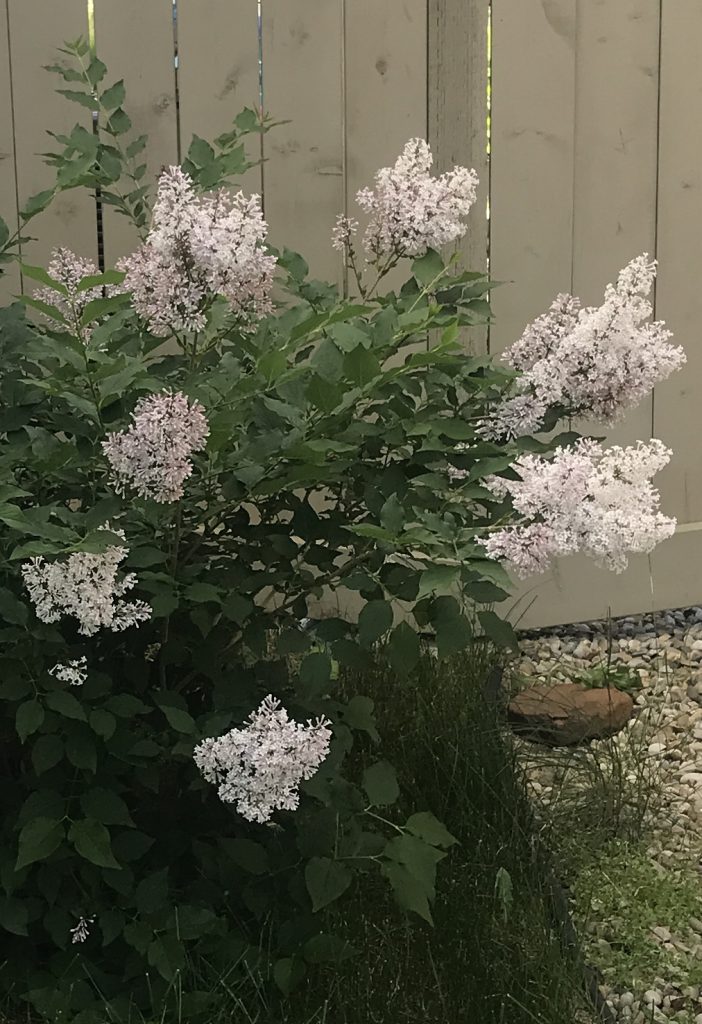
I’ve loved lilacs since I was a teen and a hedge of them grew in the park behind my house.
Ranging from white to pale pink and intense purple, lilacs bloom early in the season and are the aroma of spring for many. They range in size from just over a meter tall to over three meters.
They are a super hardy plant – you can mow it down and it will come back in the spring (ask me how I know)! It grows best in full sun, but mine is tucked away in a corner between two houses and is growing well.
Did you know lilacs are edible? Consider decorating a spring cake with the flowers, or making lilac sugar!
Be careful if you decide to prune your lilac. Blooms for next year are set shortly after it finishes blooming this year, and it’s easy to prune off next year’s flowers. Beside thinning out old growth, lilacs rarely need pruning unless you want to shape it.
Peonies
With giant blooms, peonies are a showstopping addition to your garden. They’re sensitive to being moved, but otherwise are easy to grow in full sun. It will take them 2-5 years to start blooming.
Trim them down each fall and put a cage around them to help hold the heavy blooms upright, especially if it rains!
Daylilies

Alberta has in infiltrated by the Red Lily Beetle, which loves to eat lilies of all varieties (Asiatic, martagon, oriental, tiger and trumpet). Daylilies are from a completely different family, though, and aren’t going to get eaten!
Yellow and orange are the most common to see, but there are white, pink, and even dark purple that will grow in Alberta’s Zone 3 gardens. I love my 5 foot tall orange daylilies that bloom over the month of July and into early August.
Clematis
My mom has this beautiful vine growing up the front of her house. As long as it doesn’t get too cold over the winter the old growth will flower again – it helps to trim off any dead branches in the later spring.
There are a wide variety of clematis plants available. Be sure to check the zone for any variety you are considering! My mom has the dark purple Jackmanii. Other popular varieties for Alberta include pale pink “Nelly Moser,” deep pink “Ville de Lyon,” and blue double flower “Blue Barlow.” I want to get the strikingly dark “Black Barlow” for my garden.
Dogwood

When deciding on perennials, don’t just think about the summer. Pretty in all seasons with it’s red bark, Dogwoods are a medium-large sized bush and come in so many varieties! I love the vibrancy it adds to my yard in the winter, poking up through the snow. They aren’t much for showing flowers, so look for interesting leaves to add season-round depth to your garden.
Pictured here is the Ivory Halo, available at most box stores.
Hostas

Hostas come in a variety of leaf styles, and that’s usually what people buy them for (they make amazing ground cover in the shade). But they bloom, too!
Hostas can do well in partial sun, and require good mulch or regular watering.
Abbotswood Potentilla

Some folks love them, some hate them – potentilla are a staple in garden stores and Zone 2-5 gardens. I like to use the small flowers and even smaller leaves of this compact, incredibly hardy sun loving plant to add texture to my garden.
Once established this plant is quite drought tolerant, so it’s perfect for that corner you keep forgetting to water.
Astilbe
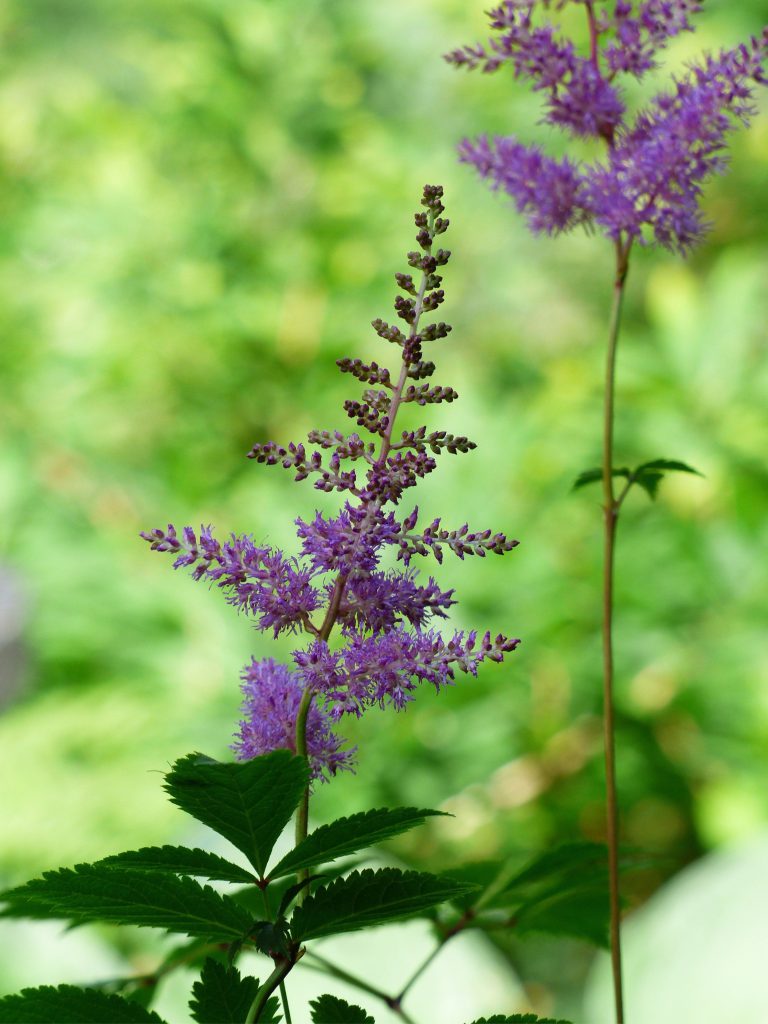
Typically reaching 2 feet tall (some varieties are a bit taller), this perennial flower does well in partially shaded spots. The flowers are beautiful long whisps in shades of white to pink to red, depending on the variety.
Mini Gallery Pink Lupine
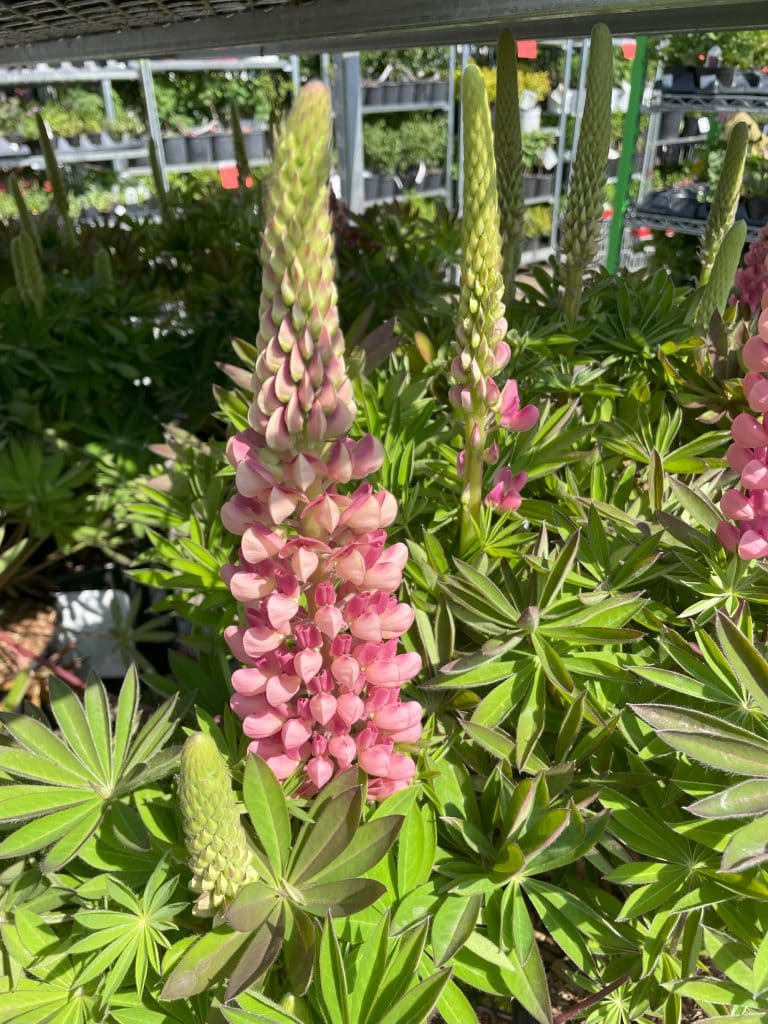
These full to part-sun flowers are able to tolerate all but the absolute worst of Alberta winters (good to -40!). Their beautiful cone shapes always make me smile. You may have heard about lupines being super toxic. This is very true for the wild plant! Domestic cultivars like this one are less so, but never eat the seeds.
Roses
You need to watch the hardiness of the particular variety you’re considering, but roses are a garden classic! Blooms come in a wide range of colours, sizes, and quantity of petals depending on the particular variety, so there is a rose for everyone.
More Perennial Flowers to Consider
I love being part of gardening groups where I get to learn about more perennials that grow in Alberta. Here are a few suggestions that have been made, but I haven’t added them to my garden yet:
- Coreopsis/tickseed
- Creeping thyme
- Pinks/dianthus
- Crocus (the flower of spring!)
- Catnip/nepeta
- Trollius/globeflower
- Stonecrop/sedums
- Phlox
- Heliopsis
- Speedwells/Veronicas
There’s also a list of just shade loving perennials in this post for the darker corners of your yard. Sometimes it’s easier to grow a garden than grass!
Can we just take a moment to admire the pretty flowers?
Looking for more?
Check out these posts:
- Shade Loving Perennials That Grow in Alberta
- Save on Plants with Alberta Plant Exchanges
- Why you should be a plant mom
- Have you been to the University of Alberta Botanic Gardens lately?
- 5 reasons we love the St Albert Botanic Park
Remember that perennials can take time to become established. What they look like when you first plant them is not what you should expect long term. Some will grow to “full sized” within a few years, but many take five to ten years or even longer to reach maturity.
Be patient, enjoy the process, and take some time to smell the flowers!
Can you make this article better?
We’re always looking to improve! Have you noticed a spelling or information error, know of something we left out, or would like to share anything else, reach out to us!
- Email us at hello@albertamamas.com
- Get social on Facebook, Instagram, TikTok, Twitter, and Pinterest
- Use our Contact Us form
- Write your own post for us!
Or share this post on Pinterest!
